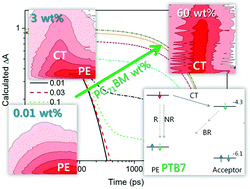Connecting charge transfer kinetics to device parameters of a narrow-bandgap polymer-based solar cell†
Abstract
To achieve intrinsically light-weight flexible photovoltaic devices, a bulk-heterojunction-type active layer with a narrow-bandgap polymer is still considered as one of the most important candidates. Therefore, detailed information about the charge transfer efficiency from a photo-excited species on an electron-donating polymer to an electron acceptor is an important factor, given that it is among the most fundamental quantitative measures to understand the solar power conversion efficiency, in particular at the initial stage followed by primary exciton formation. To obtain accurate information in this regard, wide-range acceptor concentration-dependent transient absorption spectroscopy with femtosecond laser pulse excitation was performed using a representative narrow-bandgap polymer, commonly known as PTB7. The investigated acceptor concentration range covered was from 0.01 wt% up to 10 wt%, in addition to a 0 wt% pristine polymer sample and a sample with a conventional acceptor concentration of 60 wt%, which is important for high efficiency. From the kinetic data, an almost two orders of magnitude faster acceptor-induced charge transfer rate constant in addition to the native primary exciton lifetime of about 100 picoseconds could be extracted. These data were used to verify the suggested kinetic model and compare with device properties that show no meaningful loss during the extraction of photo-generated charge carriers.



 Please wait while we load your content...
Please wait while we load your content...